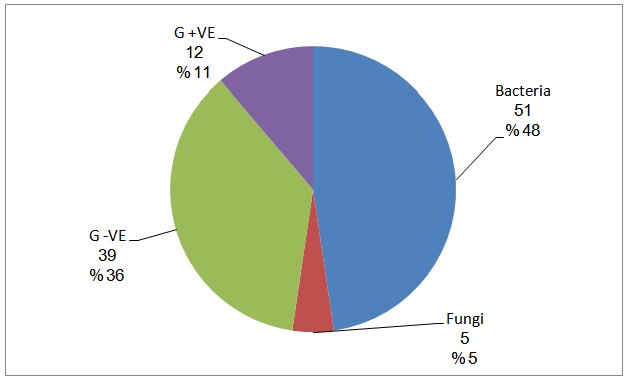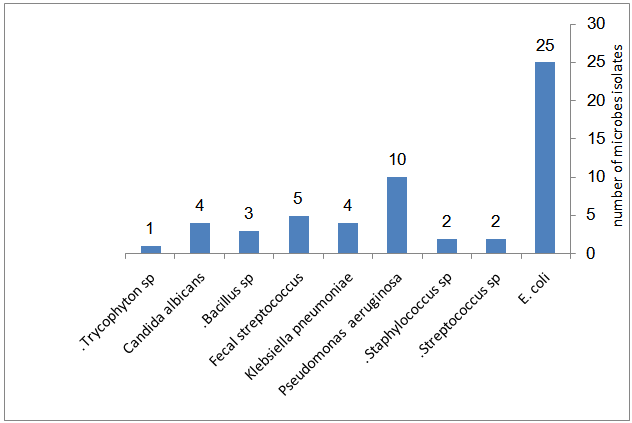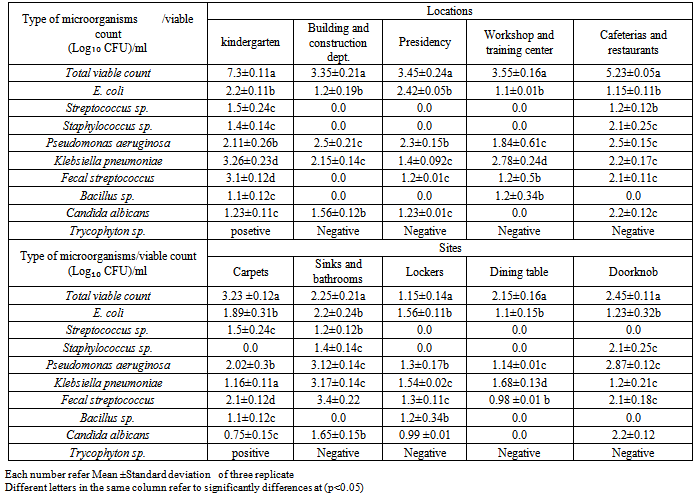-
Paper Information
- Paper Submission
-
Journal Information
- About This Journal
- Editorial Board
- Current Issue
- Archive
- Author Guidelines
- Contact Us
Journal of Health Science
p-ISSN: 2166-5966 e-ISSN: 2166-5990
2013; 3(2): 25-28
doi:10.5923/j.health.20130302.04
Comparative Assessment of Microbial Contamination from Swabs Collected within University Facilities
Azhar M. Haleem1, Daliah M. Ali Hassan2, Sedek A. K. Al-Hiyaly1
1Environmental research center, University of technology
2Workshop and training center, University of technology
Correspondence to: Azhar M. Haleem, Environmental research center, University of technology.
| Email: |  |
Copyright © 2012 Scientific & Academic Publishing. All Rights Reserved.
The present study which lasted from January to March 2013 aims to evaluate the microbial contamination within the university of technology, Baghdad. 44 swabs were collected from 7 different locations (kindergarten, Building and construction engineering department, workshops and training center, presidency, three cafeterias and restaurants). 56 microbial isolates were obtained, 51 (91.1%) bacteria and 5 (8.9%) fungi, (23.5%)of 51 bacterial isolates belong to Gram positive and 39 (76.55%) for Gram negative bacteria. The total viable count (TVC) was 7.3 log10 CFU/ ml, 3.35 log10 CFU/ ml, 3.45 log10 CFU/ ml, 3.55 log10 CFU/ ml, 5.23 log10 CFU/ ml for kindergarten, Building and construction engineering department, presidency, workshops and training center, three cafeterias and restaurants respectively, while (TVC) of carpets, sinks and bathrooms, lockers, dining table, doorknob was 3.23 log 10 CFU/ ml, 2.25 log10 CFU/ ml, 1.15 log 10 CFU/ ml, 2.15 log10 CFU/ ml, 2.45 log10 CFU/ ml respectively.
Keywords: Microbial Contamination, TVC, Swabs and Kindergarten
Cite this paper: Azhar M. Haleem, Daliah M. Ali Hassan, Sedek A. K. Al-Hiyaly, Comparative Assessment of Microbial Contamination from Swabs Collected within University Facilities, Journal of Health Science, Vol. 3 No. 2, 2013, pp. 25-28. doi: 10.5923/j.health.20130302.04.
Article Outline
1. Introduction
- Bacteria and fungi spread in all locations and spaces, because their small size and their ability to resist hard conditions beside our inability to see, all of these enable them to survive, multiply and cause serious health problems for many people[1]. Bathrooms and places of food processing (restaurants and cafeterias) play an important role in hygienic aspects which may turn into warehouses of pathogenic microbes[2]. Bacteria represent the most prevalent microbial aggregates, and Gram negative bacteria are the most widespread especially Enterobacteriaceae group which is considered one of fecal contamination indicator and their presence evidence about other pathogen[3, 4]. Gram positive bacteria no less importance in disease incidence for human such as Staphylococcus, Streptococcus, Bacillus which are caused serious health problems for human because their Virulence factors[5]. Universities a large places have many facilities such as educational, administrative, services, gardens and others, students and other staff spent more than 8 hours per day, five days a week this long time make them susceptible to different types of disease and injuries and this may lead them to absenteeism and delayed the performance of their duties. This study aims to evaluated the microbial contamination in different locates and sites within university of technology.95.3% of students and staff eat one meal at least during their presence at the university, 22.4% of staff have one or more children in the kindergarten within the university, 100% of students and staff attending the cafeterias once a week at least. 77.56% of students and staff go to the university health center for health care or for sick leave, 27.5% of sick people suffered from gastrointestinal illness, 63.45 of them suffered from respiratory tract infections 9.05% malnutrition and allergic disease.
2. Materials and Methods
2.1. Sample Collection
- The present study which is lasted from January to March 2013 within university of technology Baghdad, Iraq, aimed to evaluate microbial contamination. 44 samples (swabs) were collected from 7 different locations (kindergarten, presidency, Building and Construction Engineering department, workshops and training center and three different restaurant and cafeterias). Samples with a moisture sterile cotton swab were taken from (kitchens, dining tables, lockers, bathrooms, sinks, refrigerators, freezers, ovens, carpets, children beds and doorknobs), all swabs labeled appropriately and were transported to the laboratory within an hour for culture and treated according to standard method[6,7].
2.2. Total Viable Count
- Total viable plate count (TVC) was enumerated on Plate Count Agar (Biomark Labolatories, India), by incubating at 37ºC for 48 hrs. Yeasts and moulds were enumerated using Sabouraud Dextrose Agar (Biomark Labolatories, India) supplemented with chloramphinecol (100µg/ml) after incubating at 28ºC for 72 hrs. Escherichia coli, Enterobacteriaceae and coliform were grown on McCongy agar plates E coli diagnosed on EMB agar (Biomark Labolatories, India).Staphylococcus was determined using manittol salt agar (Biomark Labolatories, India) after incubation at 37ºC for 48 hrs. All plates were examined visually for typical colony types and morphological characteristics associated with each growth medium. Suspected colonies were tested biochemically by the methods as described in the Food and Drug Administration Bacteriological Analytical Manual)[8].
2.3. Statistical Analyses
- Descriptive statistical analysis (frequency, percentage) were employed using SPSS version 16, one ANOVA was used for multiple comparisons and statistical difference considered significant at P≤0.05.
3. Results and Discussions
- From table figure 1 and 2, 44 swabs were collected gave 56 microbial isolates, 51 (91.1%) bacteria and 5 (8.9%) fungi, 39 (76.5%) Gram negative bacteria and 12 (23.5%) Gram positive bacteria. Enterobacteriaceae group was most prevalent than other bacteria, four isolates of Candida albicans and one dermatophytes Trycophyton sp. was isolated through this study (fig 1, 2).
 | Figure 1. Distribution of microbial group frequency |
 | Figure 2. Distribution of microbial species frequency |
3.1. Total Viable Count
|
 Abstract
Abstract Reference
Reference Full-Text PDF
Full-Text PDF Full-text HTML
Full-text HTML